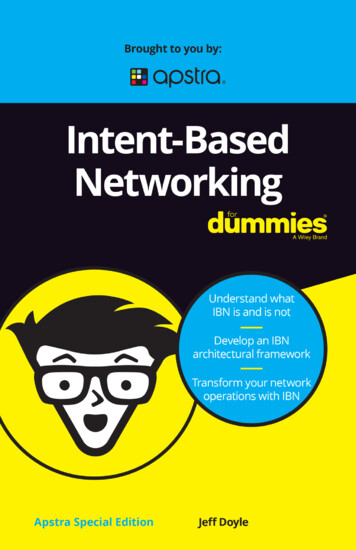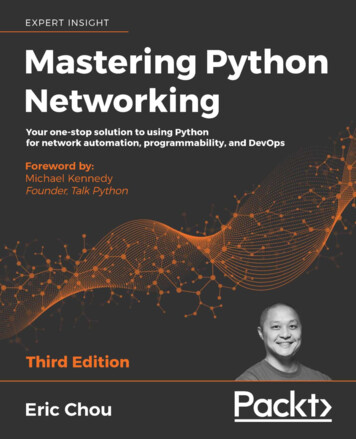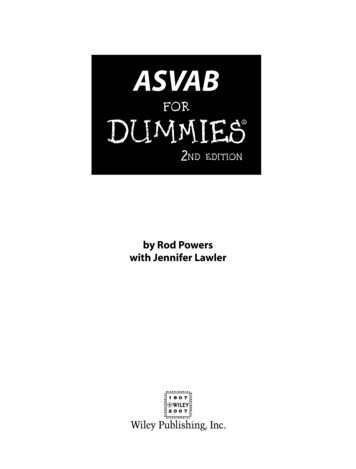
Transcription
These materials are 2020 John Wiley & Sons, Inc. Any dissemination, distribution, or unauthorized use is strictly prohibited.
Intent-BasedNetworkingApstra Special Editionby Jeff DoyleThese materials are 2020 John Wiley & Sons, Inc. Any dissemination, distribution, or unauthorized use is strictly prohibited.
Intent-Based Networking For Dummies , Apstra Special EditionPublished byJohn Wiley & Sons, Inc.111 River St.Hoboken, NJ 07030-5774www.wiley.comCopyright 2020 by John Wiley & Sons, Inc.No part of this publication may be reproduced, stored in a retrieval system or transmitted in anyform or by any means, electronic, mechanical, photocopying, recording, scanning or otherwise,except as permitted under Sections 107 or 108 of the 1976 United States Copyright Act, withoutthe prior written permission of the Publisher. Requests to the Publisher for permission should beaddressed to the Permissions Department, John Wiley & Sons, Inc., 111 River Street, Hoboken, NJ07030, (201) 748-6011, fax (201) 748-6008, or online at http://www.wiley.com/go/permissions.Trademarks: Wiley, For Dummies, the Dummies Man logo, The Dummies Way, Dummies.com,Making Everything Easier, and related trade dress are trademarks or registered trademarks ofJohn Wiley & Sons, Inc. and/or its affiliates in the United States and other countries, and may notbe used without written permission. Apstra and the Apstra logo are registered trademarks ofApstra. All other trademarks are the property of their respective owners. John Wiley & Sons, Inc.,is not associated with any product or vendor mentioned in this book.LIMIT OF LIABILITY/DISCLAIMER OF WARRANTY: THE PUBLISHER AND THE AUTHOR MAKE NOREPRESENTATIONS OR WARRANTIES WITH RESPECT TO THE ACCURACY OR COMPLETENESS OFTHE CONTENTS OF THIS WORK AND SPECIFICALLY DISCLAIM ALL WARRANTIES, INCLUDINGWITHOUT LIMITATION WARRANTIES OF FITNESS FOR A PARTICULAR PURPOSE. NO WARRANTYMAY BE CREATED OR EXTENDED BY SALES OR PROMOTIONAL MATERIALS. THE ADVICEAND STRATEGIES CONTAINED HEREIN MAY NOT BE SUITABLE FOR EVERY SITUATION. THISWORK IS SOLD WITH THE UNDERSTANDING THAT THE PUBLISHER IS NOT ENGAGED INRENDERING LEGAL, ACCOUNTING, OR OTHER PROFESSIONAL SERVICES. IF PROFESSIONALASSISTANCE IS REQUIRED, THE SERVICES OF A COMPETENT PROFESSIONAL PERSON SHOULD BESOUGHT. NEITHER THE PUBLISHER NOR THE AUTHOR SHALL BE LIABLE FOR DAMAGES ARISINGHEREFROM. THE FACT THAT AN ORGANIZATION OR WEBSITE IS REFERRED TO IN THIS WORKAS A CITATION AND/OR A POTENTIAL SOURCE OF FURTHER INFORMATION DOES NOT MEANTHAT THE AUTHOR OR THE PUBLISHER ENDORSES THE INFORMATION THE ORGANIZATIONOR WEBSITE MAY PROVIDE OR RECOMMENDATIONS IT MAY MAKE. FURTHER, READERSSHOULD BE AWARE THAT INTERNET WEBSITES LISTED IN THIS WORK MAY HAVE CHANGED ORDISAPPEARED BETWEEN WHEN THIS WORK WAS WRITTEN AND WHEN IT IS READ.For general information on our other products and services, or how to create a custom For Dummiesbook for your business or organization, please contact our Business Development Departmentin the U.S. at 877-409-4177, contact info@dummies.biz, or visit www.wiley.com/go/custompub.For information about licensing the For Dummies brand for products or services, contact BrandedRights&Licenses@Wiley.com.ISBN: 978-1-119-68377-3 (pbk); ISBN: 978-1-119-68366-7 (ebk)Manufactured in the United States of America10 9 8 7 6 5 4 3 2 1Publisher’s AcknowledgmentsSome of the people who helped bring this book to market include the following:Project Editor:Carrie Burchfield-LeightonDevelopment Editor: Ryan WilliamsEditorial Manager: Rev MengleAcquisitions Editor: Ashley CoffeeBusiness DevelopmentRepresentative: Karen HattanProduction Editor:Mohammed Zafar AliThese materials are 2020 John Wiley & Sons, Inc. Any dissemination, distribution, or unauthorized use is strictly prohibited.
Table of ContentsINTRODUCTION. 1About This Book. 1Icons Used In This Book. 2Beyond the Book. 2CHAPTER 1:Expressing Intent and Seeing theBasics of IBN. 3Looking at the Challenges of Digital Transformation. 3The human interface. 4The human interpreter. 5Inadequate automation. 5Data overload. 6Stale documentation. 6Making the Transformation with IBN. 6Digging Deeper into IBN. 8You say what, it says how. 9Information flows. 10Following the full life cycle support. 11Understanding What IBN Is Not. 13IBN is not automation. 14IBN is not configuration management. 14IBN is not SDN. 14IBN is not orchestration. 14IBN is not a policy engine. 15CHAPTER 2:Looking at the Characteristics of IBN. 17Understanding the Fundamental Aspects of IBN. 17Intent fulfillment. 18Intent assurance. 19Idempotency. 19Single Source of Truth. 20Simple Pane of Glass. 21Speak the Truth. 22Table of ContentsiiiThese materials are 2020 John Wiley & Sons, Inc. Any dissemination, distribution, or unauthorized use is strictly prohibited.
CHAPTER 3:Detailing the IBN Architecture. 23Making the Big Stuff Small. 23Getting a High-Level View of IBN. 25The Reference Section. 26Making It Abstract. 27Keep it logical. 28Off the rack. 28Creating templates. 28Taking Inventory. 29Make a profile. 30Dealing with the elements. 30Get out the maps. 30Resources. 31Looking at the Blueprint. 31Pushing It All to the Infrastructure. 31CHAPTER 4:Staying Alert with Intent-Based Analytics. 33Experiencing Two Types of Change. 33Uncontrolled change. 34Controlled change. 34Discovering Actionable Insights. 35Probing Your Data. 36Getting to the Root. 37Reaching Back in Time. 38CHAPTER 5:Ten Things to Think About WhenConsidering IBN. 41Don’t Start with Hardware. 41Free Yourself from Vendor Lock-In. 42Sort through the Fluff. 42Don’t Rely on Home-Grown Solutions. 42Automation Is Only Part of the Story. 43Rid Yourself of Calculated Guesswork. 43Empower New Ways of Thinking. 44ivIntent-Based Networking For Dummies, Apstra Special EditionThese materials are 2020 John Wiley & Sons, Inc. Any dissemination, distribution, or unauthorized use is strictly prohibited.
IntroductionDigital transformation is all about applications and agility.Modern digital services are usually built from multipleapplications — especially in this age of microservices —and both your staff and your network must be optimized forquickly creating and deploying new services, for changing services at the drop of a hat, and for quickly scaling applications thatcan experience 50 to 100 percent yearly growth.According to a 2018 McKinsey survey, 68 percent of respondents’ objectives were digitizing the organization’s entire operating model; less than half had a more limited objective of eitherlaunching new products or services or interacting with externalpartners through digital channels. The same survey reported thatless than 30 percent succeed, with organizations of fewer than 100employees reporting a successful digital transformation, 2.7 timesmore often than organizations with more than 50,000 employees.Research shows that digital transformation is a huge endeavor.The last thing you need is for your network to get between yourinnovative new services and your customers, employees, andpartners.Intent-based networking (IBN) has become a hot buzzword in thenetworking industry, with marketing departments at all sorts ofvendors waving the “intent flag.” Some have legitimate products,some have cobbled together bits and pieces out of their productportfolios and called it an IBN solution, and some supposed IBNproducts perform only a part of what a real IBN system (IBNS) does.About This BookThis book waves away the fog to provide you with a clear understanding of what IBN really is. You look at what intent means inthe context of network operations and how an IBNS applies thatintent to a network across its entire life cycle. You also delve intowhat features and characteristics an IBNS requires to fulfill itsmission. You look at practical examples and testing of IBN beforecircling back to the benefits, just so you leave with a good feelingabout the whole thing.Introduction1These materials are 2020 John Wiley & Sons, Inc. Any dissemination, distribution, or unauthorized use is strictly prohibited.
Icons Used In This BookYou may notice some little pictures in the margins of this book.Some you can ignore; some you may want to peruse more closely.This section helps you make your determination and maybe savea little time.This icon gives you a little extra help, saves you time, or may evensave you money. Check them out if you’re not in a hurry.This icon emphasizes an important fact. Keep this in mind.Pay more attention to these icons. You want things to keep running well and with a minimum of disaster, right? These icons aresuggestions of things to avoid those disasters.Isn’t this book all technical stuff? Well, not exactly, but someinformation is more technical than the rest. If you aren’t a supertechie, you can skip this info.Beyond the BookThis book helps you discover more about IBN, but if you wantresources beyond what this book offers, I have some insight foryou:»» Download a free eBook on the benefits of IBN in thedata center. nter»» Download Apstra’s whitepaper on the IBN hitecture-overview»» Dive deeper into the requirements for a good IBNsystem. intent-032Intent-Based Networking For Dummies, Apstra Special EditionThese materials are 2020 John Wiley & Sons, Inc. Any dissemination, distribution, or unauthorized use is strictly prohibited.
IN THIS CHAPTER»» Perusing the challenges of digitaltransformation»» Reviewing the high-level functions of IBN»» Evaluating the different levels ofmaturity of an IBNS»» Differentiating a true IBNSChapter1Expressing Intent andSeeing the Basics of IBNIntent-based networking (IBN) is far more than just networkmanagement. The fault, configuration, accounting, performance, and security (FCAPS) management framework is allpart of an IBN system (IBNS). But those aspects are just capabilities, not IBNS itself.Okay, then what is it? This chapter gives you a bit of the challenges of transformation and then tells you why IBN is beneficialto this transformation.Looking at the Challenges ofDigital TransformationMultiple industry studies indicate that by the end of 2021, organizations will be three times more likely to fail in their digital businesstransformation if they don’t adjust their operational practices. Butmost IT organizations — around 82 percent — struggle to justkeep running, leaving meager funding for innovative development.CHAPTER 1 Expressing Intent and Seeing the Basics of IBN3These materials are 2020 John Wiley & Sons, Inc. Any dissemination, distribution, or unauthorized use is strictly prohibited.
Similarly, network architects spend more than 50 percent of theirtime serving as top-tier operational support when they should befocused on staying on top of technology trends and developingthree- and five-year plans incorporating those trends.Data center technologies have evolved to support digital transformation. Micro-segmentation, containerization, microservices, and service virtualization all contribute to building agiledigital environments. Orchestration systems ease the operationalburden, at least for storage and compute, by operating on anabstracted model of the physical systems.And although network virtualization technologies such as Virtually Accessible LAN (VXLAN) and Ethernet VPN EVPN support highlymobile digital end systems and applications, network operationslag so far behind on the transformation curve that it often inhibitschange instead of promoting it.More often than not, a network’s operational problems springdirectly from humans interfaced too close to the systems.The human interfaceHumans are slow, expensive, error prone, and inconsistent.They’re irreplaceable when interacting with systems at a levelwhere insights are unique, but when interfaced directly to network systems via CLIs, on-the-fly scripting, or web-based configuration management tools, the systems are vulnerable to smallmistakes that can have enormous costs to the business. Strongchange management polices reduce error rates, but at the price ofeven slower change processes.THE OPEX CHALLENGEOnce upon a time, organizations dealt with soaring operationalexpenses (OPEX) by reducing staff — leaving the remaining personnelto pick up the slack. But reducing operations staff when IT is vital toyour business just compounds your problems. Today OPEX reductionis about reducing the time required to perform the countless individual tasks of operating a network.4Intent-Based Networking For Dummies, Apstra Special EditionThese materials are 2020 John Wiley & Sons, Inc. Any dissemination, distribution, or unauthorized use is strictly prohibited.
The thing is, humans are marvelously talented at pattern recognition and have mad skills at developing unexpected solutions fromavailable data (you know, what you usually call thinking outsidethe box, or innovation).What humans are not good at are mundane, repetitive tasks over along period. People get bored and make mistakes. One mistake toomany and your company is on the cover of the Wall Street Journalfor all the wrong reasons.The human interpreterThere’s a linear progression from business intent to a successfulnetwork process. In the middle is an essential human translationlayer: the network architect. This person consumes vast amountsof coffee and meeting time, takes business intent as an input,translates that to technical intent, and outputs workable networkconfigurations.Just like the human interface in the operations center, the humaninterpreter is irreplaceable for the abstract parts of the job but isslow and error-prone at the lower task-oriented part of the job.And they’re not called network architects for nothing. The job hasa distinct design element to it that, while extremely important,can drift into individual styles that introduce inconsistencies toyour network.Individualism matters if you’re Michelangelo or Miles Davis.Individualism in network design can be dangerous.Inadequate automationWhether it’s handling repetitive operational tasks or generatingand pushing new configurations, operators and architects havelong recognized the value of automation both as a labor-savingtool and as a means of reducing human error.Most automation tools, from old Tcl and Python scripts to modern provisioning software like Ansible, take input for a specifictask and output configurations specific to your current network.If your network changes — you add new features, or you changevendors — your scripts must change with your network. Andrunning a multi-vendor network can mean maintaining multiplescripts that do the same thing.CHAPTER 1 Expressing Intent and Seeing the Basics of IBN5These materials are 2020 John Wiley & Sons, Inc. Any dissemination, distribution, or unauthorized use is strictly prohibited.
Even if you build a large library of scripts over the years, they’relikely to be disjointed and more oriented to Day 0 provisioningthan to managing the full life cycle of your network.Data overloadIt’s not that most of your swarm of data is unimportant. It’s thatdifferent data is important at different times. How do you sortthrough it all, and how do you determine what data points aredirectly related? What do the interrelationships tell you about thehealth of your network? When an anomaly appears, how do youidentify the data that points to a root cause?The challenge in a transformative network isn’t the flood of data.It’s being able to run analysis on the data, within context and innear real time.Stale documentationMaintaining up-to-date documentation is a challenge even formost legacy networks. Networks supporting modern digital services change not just day-to-day or hour-to-hour, but oftensecond-to-second. Humans, and even many automated documentation systems, simply can’t keep up. Yet without an accuratemap of the physical and logical infrastructure, you can’t safelymaintain the rates of change demanded by digital services.Does that seem like circular reasoning? It is, unless your networkis self-documenting.Making the Transformation with IBNIBN smooths many of the speed bumps standing in the way of successfully transforming and operating your network by supportingrapid, at-scale changes, making your network more autonomicthroughout its life cycle, and providing insights into your networkthat are always up-to-date. You can manage what requires automation, make your system standardized and reliable, and ensureyou’re free to move and adjust heading into the future.While capital expenses (CAPEX) are certainly nothing to sneeze at,the budget IT executives continually struggle to get under control is operational expenses (OPEX). IBN is all about getting OPEXunder control in a variety of ways.6Intent-Based Networking For Dummies, Apstra Special EditionThese materials are 2020 John Wiley & Sons, Inc. Any dissemination, distribution, or unauthorized use is strictly prohibited.
In transforming the way you operate your network, with IBNyou’ll see the following benefits:»» Managed complexity: Break operational tasks down totheir simplest elements and automate them, based onexpected outcomes.»» Managed risk: Eliminate human error in the flow fromexpressed intent to creation and deployment of specificconfigurations.»» Managed “data fog”: Get actionable insights into themassive big data telemetry your network is throwing atyou, eliminating the heavy operational expense of extracting only the data you need at a specific moment.»» Increased reliability: Operations that run 24/7/365 makemaintenance windows increasingly difficult to schedule.Network changes under IBN are markedly faster and canoften be performed in production.»» Standardized network segments: Use validated, best-practice blueprints to quickly stamp out reliable, industrystandard network segments.»» Accelerated agility: Everyone talks about network agility. Allit means is the ability to adapt to changes and new applications without major structural changes. Agility is directly tiedto operational cost savings.»» Freeing your experts: IBN means your architecture teamspends less time fighting fires and more time working onstrategic initiatives.»» Surveying your options: Dealing with the quirks of individualnetwork operating systems unnecessarily lengthens deployment times. They can even force architects to adapt to vendorcapabilities instead of what’s best for the business. IBN putsdesign first and deals with vendor specifics in the background.»» Moving from days to minutes: Imagine that you need todeploy ten new leaf switches in their data center. Afterracking and cabling everything, you also need to upgrade theoperating systems. Next, develop, validate, and deploy new.Finally, it’s time to run your acceptance tests. Altogether,bringing the new switches online can take multiple days.After moving to an IBN system (IBNS), the same project —from design to deployment and acceptance testing — takes20 minutes.CHAPTER 1 Expressing Intent and Seeing the Basics of IBN7These materials are 2020 John Wiley & Sons, Inc. Any dissemination, distribution, or unauthorized use is strictly prohibited.
FLYING ON AUTO-PILOTSimply put, IBN lets software do what software does best — performmundane operational tasks quickly, accurately, and cheaply.Boeing 777 pilots report that they spend approximately seven m inutesmanually flying the plane on an average trip. They input the flightparameters (intent), and the plane’s internal systems translate thatexpressed intent into all the operational minutiae necessary to complete the flight. Along the way, the systems constantly adjust to ensureconstant compliance with the expressed mission objectives.The 777 pilot isn’t eliminated, and the pilot’s role isn’t trivial. To thecontrary, the pilot is relieved of the simple minute-to-minute tasksand can better apply his expertise to the overall mission. The pilot canalways take over in the event of a system failure. Increasingly, though,the system can also take over in the event of a pilot error.The parallels to IBN are powerful. You express your technical intent,and the system takes over the mundane tasks of not only deployingand operating your network in compliance with your intent but alsoconstantly ensuring that the network doesn’t deviate from intent.Your network is its own auto-pilot.Digging Deeper into IBNIBN takes your network — regardless of the specific vendor oroperating system of your network devices — from piecemealnode-by-node management to an autonomic network. The system self-operates, self-adjusts, and self-corrects within theparameters of your expressed technical objectives.Those expressed technical objectives are your intent. Intent is adeclarative statement of expected outcomes. Traditionally, network architects conduct engineering meetings where intent is theinput and executable, device-specific configurations are the output. Outputs can also include validation of the network configurations and operational parameters for continued compliance.That’s where an IBNS comes in. An IBNS takes your intent asinput, translates your intent first into actionable policies foryour network, and then executes device-specific configurations.8Intent-Based Networking For Dummies, Apstra Special EditionThese materials are 2020 John Wiley & Sons, Inc. Any dissemination, distribution, or unauthorized use is strictly prohibited.
It validates the outcomes and actively monitors the network forintent compliance, adjusting network parameters as needed toensure compliance throughout the network life cycle. The result,as shown in Figure 1-1, is vastly simplified, highly reliable network operations.FIGURE 1-1: A 30,000-foot view of an IBNS.You say what, it says howIntent in the context of IBN is a declarative statement. How veryacademic. An easier way to define it is that you tell an IBNS whatyou want, and the system decides how to do it. Gone is the humaninterface translating expressed intent into executable configurations, injecting individual interpretations (read: inconsistencies)and possibly mistakes into the configuration. The IBNS performsthe translation, consistently and accurately.Take this list, for example:»» Deploy an L2 network interconnecting VMs for application Xin the data center.»» Ensure 3:1 oversubscription or better on all links.»» Isolate the network from all other tenants in the data center.»» Provide external access through routers Y1 and Y2, applyingsecurity policy Z.CHAPTER 1 Expressing Intent and Seeing the Basics of IBN9These materials are 2020 John Wiley & Sons, Inc. Any dissemination, distribution, or unauthorized use is strictly prohibited.
The IBNS accepts this declaration of operational requirementsand references a blueprint consisting of services, resources, anda reference design. The network validates the requirements andcreates configurations specific to individual nodes. Finally, thenetwork automatically pushes this information to the physicalnetwork infrastructure.Information flowsFigure 1-1, earlier in this chapter, shows the flow of informationfrom your expressed intent (desired outcomes) through the elements of the IBNS to the physical network. This isn’t enough. IBNhas to know these factors as well:»» The topology of the physical infrastructure»» The vendor and operating system version of each network node»» The resources available at each node and linkSo, information not only flows down from the IBNS to theinfrastructure but also flows up from the infrastructure to theIBNS. Figure 1-2 shows you the system that must collect the information necessary to represent the network and monitor networkresources and states.FIGURE 1-2: Information must be collected from the network to appropriatedata stores.10Intent-Based Networking For Dummies, Apstra Special EditionThese materials are 2020 John Wiley & Sons, Inc. Any dissemination, distribution, or unauthorized use is strictly prohibited.
This two-way flow extends IBN beyond mere deployment to network support through its entire life cycle.Following the full life cycle supportFour phases define the network life cycle:1.2.3.4.Design.Build.Deploy.Validate.You can roughly judge the maturity of an IBN product by howthoroughly it supports the network in all four of these phases. Butyou can evaluate an IBN offering even more effectively by using anobjective, fact-based taxonomy to categorize its level of development. Figure 1-3 shows a taxonomy for four levels of IBN deployment. Each level is increasingly impactful on business operations.FIGURE 1-3: The IBN taxonomy.Level 0: Basic automationAt Level 0, a basic IBN solution can generate configurations basedon declarative statements and push them out to network nodes.Although there’s probably some “upward” information flow fromthe network devices, IBN at this stage is likely to be limited to asingle vendor. The information can be message-centric, ratherthan data-centric. What’s missing is a single source of truth.CHAPTER 1 Expressing Intent and Seeing the Basics of IBN11These materials are 2020 John Wiley & Sons, Inc. Any dissemination, distribution, or unauthorized use is strictly prohibited.
Level 1: Single source of truthA single source of truth, illustrated in Figure 1-4, makes IBNdata-centric rather than message-centric. The single source oftruth stores both expressed intent and of recursively updated network state.FIGURE 1-4: Level 1 IBN requires a single source of truth.A single source of truth can query the database (instead of thenetwork) at any time for either existing state, such as “What isthe status of interface X on node Y?” You can also ask potentialstates, such as “What is the impact on bandwidth utilization if Itake node Z offline?”Level 2: Real-time change validationReal-time change validation requires an addition to the information flows from Figure 1-2 in the earlier section “Informationflows.” Real-time, closed-loop telemetr
Intent-based networking (IBN) has become a hot buzzword in the networking industry, with marketing departments at all sorts of vendors waving the "intent flag." Some have legitimate products, some have cobbled together bits and pieces out of their product portfolios and called it an IBN solution, and some supposed IBN










